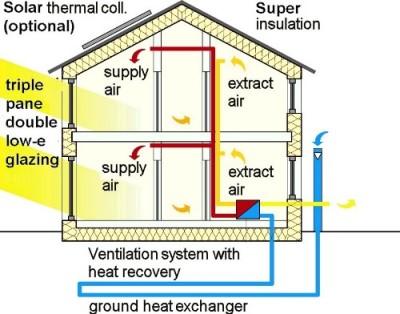Passive house (Passivhaus in German) refers to a rigorous, voluntary standard for energy efficiency in a building, reducing its ecological footprint. It results in ultra-low energy buildings that require little energy for space heating or cooling.
A building standard that is truly energy efficient, comfortable, affordable and ecological at the same time.
Passive House is not a brand name, but a construction concept that can be applied by anyone and that has stood the test of practice.
Yet, a Passive House is more than just a low-energy building.
Passive Houses allow for heating and cooling related energy savings of up to 90% compared with typical building stock and over 75% compared with average new builds. In terms of heating oil, Passive Houses use less than 1.5 litres per square meter of living space per year – far less than typical low-energy buildings. Similar energy savings have been demonstrated in warm climates where buildings require more energy for cooling than for heating.
Passive Houses are also praised for their high level of comfort. They use energy sources inside the building such as the body heat from the residents or solar heat entering the building – making heating a lot easier.
Appropriate windows with good insulation and a building shell consisting of good insulated exterior walls, roof and floor slab keep the heat during winter in the house – and keep it out during summer.
A ventilation system consistently supplies fresh air making for superior air quality without causing any unpleasant draughts. This is e.g. a guarantee for low Radon levels and improves the health conditions. A highly efficient heat recovery unit allows for the heat contained in the exhaust air to be re-used.
The Passive House is the world leading standard in energy-efficient construction: A Passive House requires as little as 10 percent of the energy used by typical Central European buildings – meaning an energy savings of up to 90 percent. Owners of Passive Houses are barely concerned with increasing energy prices.
-
The heating/cooling load is limited to a maximum of 10 W/m2
-
Conventional Primary energy use may not exceed 120 kWh/(m²a) – but the future is renewable energy supply (PER) with no more than 60 kWh/(m²a). This is easy to accomplish with passive houses.
-
Passive Houses must be airtight with air change rates being limited to n50 = 0.6/h.
-
In warmer climates and/or during summer months, excessive temperatures may not occur more than 10 % of the time.
The Passive House is a sustainable construction concept that provides for affordable, high-quality buildings as well as comfortable, healthy living conditions. And its principles are quite easy to understand:
As newer buildings are increasingly airtight, ventilation through joints and cracks alone is not sufficient to provide for fresh indoor air. Opening the windows as recommended won’t do the job either. Fresh air is not merely a matter of comfort but a necessity for healthy living – Indoor Air Quality (IAQ) is the basic performance goal. Ventilation systemsare therefore the key technology for all future residential buildings and retrofits.
Even though ventilation systems do require an extra investment to begin with they will end up saving considerable amounts of energy costs, provided that they are highly efficient systems. Passive House quality ventilation systems will reduce the operating costs of any building.
This is where the Passive House concept comes in: As large amounts of fresh outdoor air need to be supplied to the building anyway, why not use this air for heating? – Without any extra amounts of air, without any recirculation of air, without any inconvenient noise or drafts? This way the ventilation system pays off twice.
This “supply air heating” concept only works in appropriately insulated buildings – that is in Passive Houses. In expert terms: The transmission and infiltration heating load must be less than 10 W/m² to make sure that the required heat can be provided by the supply air.
For more details visit: http://nypassivehouse.org/
http://www.phius.org/home-page


Comments are closed.